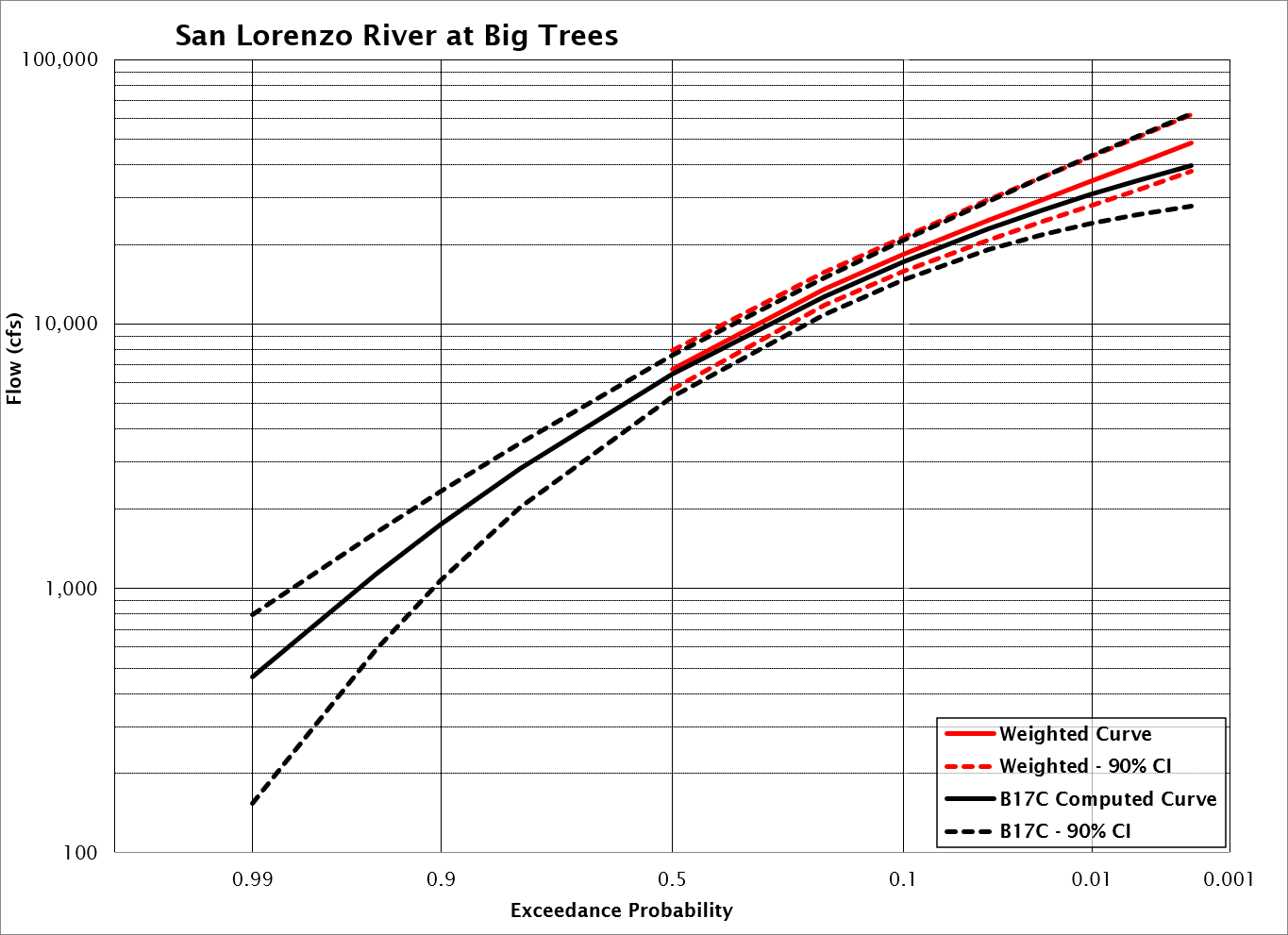Download PDF
Download page Combining Flow Frequency Curves Determined by Independent Estimates.
Combining Flow Frequency Curves Determined by Independent Estimates
Software Version
HEC-HMS version 4.10 was used to create this example. You can open the example project with HEC-HMS 4.10 or a newer version.
Introduction
Bulletin 17C contains guidance for combining independent flow frequency curves. Specifically, Appendix 9 provides an example where information from a Bulletin 17C analysis is combined with a flow frequency estimate from a regional analysis. This example shows how to combine a Bulletin 17C flow frequency curve with flow frequency information from precipitation-runoff modeling using HEC-HMS. The same watershed and model from the Modeling Flow-Frequency Relationships using HEC-HMS tutorial was used as the starting point for this example.
This example only includes uncertainty in the hypothetical storm's temporal pattern. Other sources of uncertainty that could have been included are uncertainty in the precipitation depth, depth-area reduction, spatial pattern, initial conditions and hydrologic process parameters.
Steps
- Additional temporal patterns were added to the SanLorenzo HEC-HMS project. The Atlas 14 10-, 50-, and 90-percent patterns were added from each quartile. Also, the 2017 time pattern was added; the 1982 time pattern was already in the project. The following figure shows the twelve Atlas 14 temporal patterns that were added to the project (as Percentage Curves). These temporal patterns are saved in the Atlas14TemporalPatterns.dss file located in the ...\SanLorenzo\data directory.
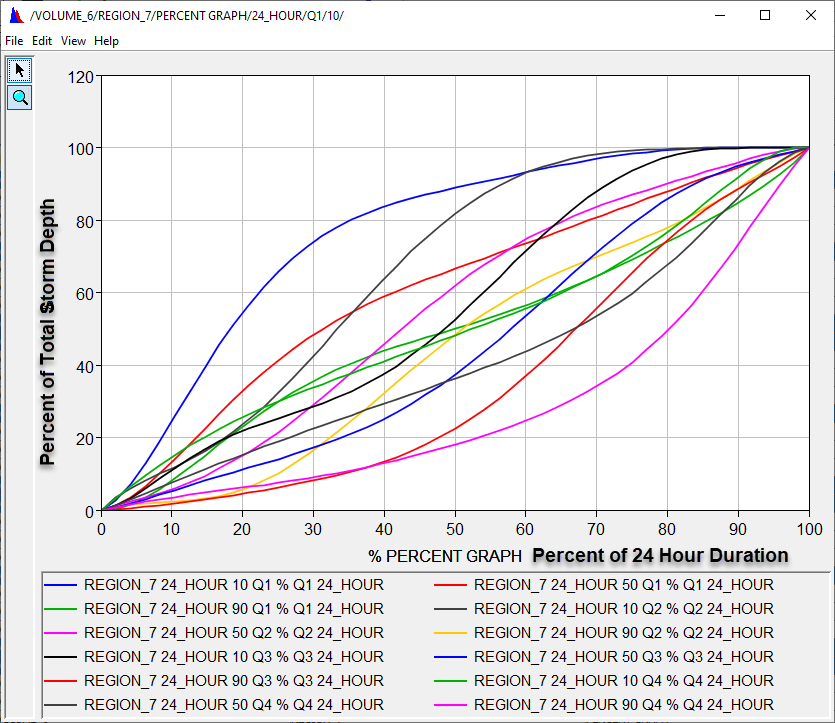
- The following figure shows a portion of Table A.6.1 in Atlas 14 Volume 6. The San Lorenzo watershed is in California region 7. Table A.6.1 shows 680 storms were used to build the thirty-six 24-hour temporal patterns. Also, the number of events per quartile is somewhat consistent; therefore three time patterns from each quartile were selected.
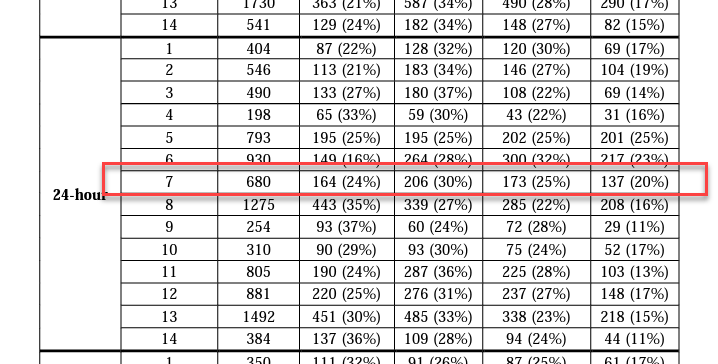
- The following figure shows all 14 temporal patterns in the HEC-HMS project.
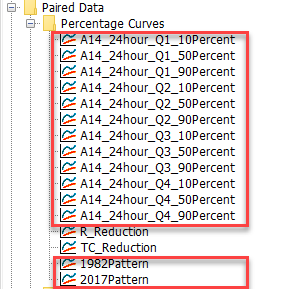
- A separate meteorologic model was created for each precipitation frequency and temporal pattern combination. There are fourteen temporal patterns, and the example is set up to compute the 50-, 20-, 10-, 4-, 2-, 1-, 0.5-, and 0.2-percent Annual Exceedance Probability (AEP) events. This means 112 separate meteorologic models were added to the project. Descriptive names, based on the temporal pattern, were used to name each meteorologic model. The component editor for each meteorologic model was edited to select the correct temporal pattern. The following figure shows a portion of the meteorologic models and the component editor for the 0.2%_24hr_A14Q1_10P meteorologic model.
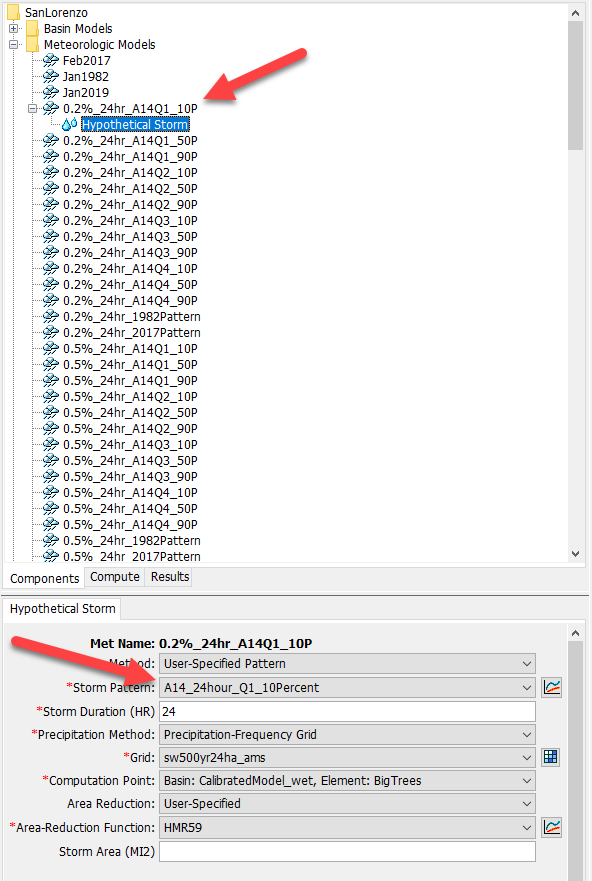
- The Frequency Analysis compute was a time saver in this example. Instead of creating 112 separate simulation runs, 14 frequency analysis computes were created and configured. The following figure shows all 14 frequency analysis computes, Ordinate 1 in the A14Q1_10P_TimePattern analysis is selected. Ordinate 1 is the 50 percent event, it uses the 50%_24hr_A14Q1_10P meteorologic model. The other seven ordinates have the correct meteorologic models selected (all use the same time pattern).
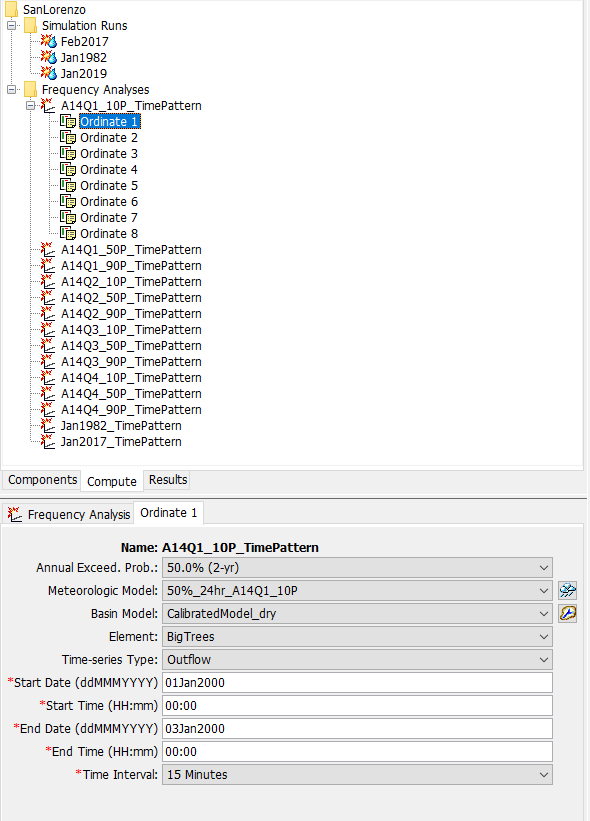
- The Frequency Analyses were computed using the Multiple Compute option available from the Compute menu.
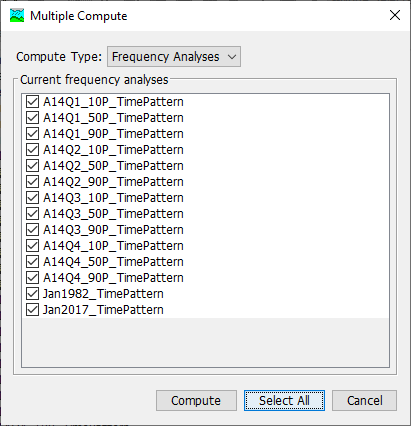
- Another useful feature of the frequency analysis is that peak flow results at the element of interest are summarized for each ordinate. The figure below shows the flow frequency information for all 8 frequency events using the A14_24hour_Q1_10Percent temporal pattern.
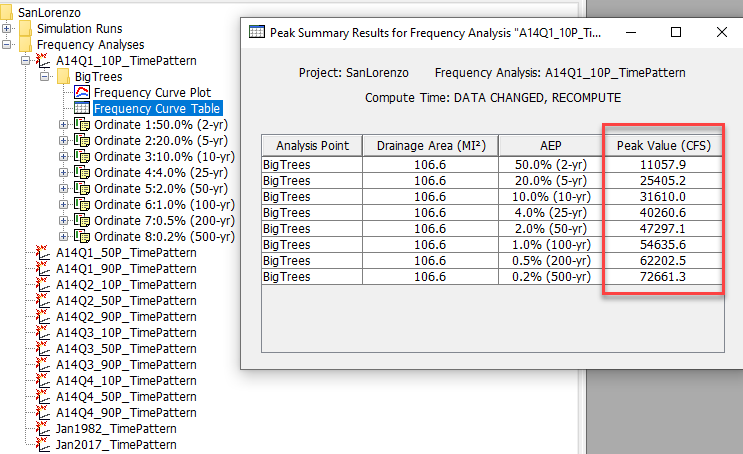
The following table contains the flow-frequency results from the HEC-HMS simulations.
AEP Flow (cfs) for Pattern: 1982 Pattern 2017 Pattern A14Q1_10P Pattern A14Q1_50P Pattern A14Q1_90P Pattern A14Q2_10P Pattern A14Q2_50P Pattern A14Q2_90P Pattern A14Q3_10P Pattern A14Q3_50P Pattern A14Q3_90P Pattern A14Q4_10P Pattern A14Q4_50P Pattern A14Q4_90P Pattern 0.5 5390 12394 11058 4723 6770 10840 7385 5780 9969 9211 10150 7539 9921 14558 0.2 15048 22947 25405 15495 13001 22021 17055 15045 19370 18617 20288 14600 18514 25841 0.1 19403 29027 31610 19700 16506 27576 21650 19234 24369 23463 25516 18538 23238 32763 0.04 25273 37507 40261 25188 21240 35024 27744 24795 31026 29877 32444 23785 29689 42435 0.02 29992 43937 47297 29434 25083 41068 32421 29070 36383 34927 37997 27882 35010 50172 0.01 34999 50727 54636 33922 29192 47522 37389 33526 42116 40338 43921 32385 40706 57772 0.005 39900 57703 62203 38727 33627 54389 42718 38297 48223 46111 50226 37185 46777 65583 0.002 47028 67574 72661 45673 39995 63921 50290 45106 56887 54304 59175 44049 55413 76529 The following figure shows the HEC-HMS derived flow frequency results plotted along with the observed annual peak flow data and the Bulletin 17C flow frequency curve.
As was noted earlier, the spread/uncertainty in the HEC-HMS flow frequency results is only due to the 24 hour storm temporal patterns, which are based on historical events.
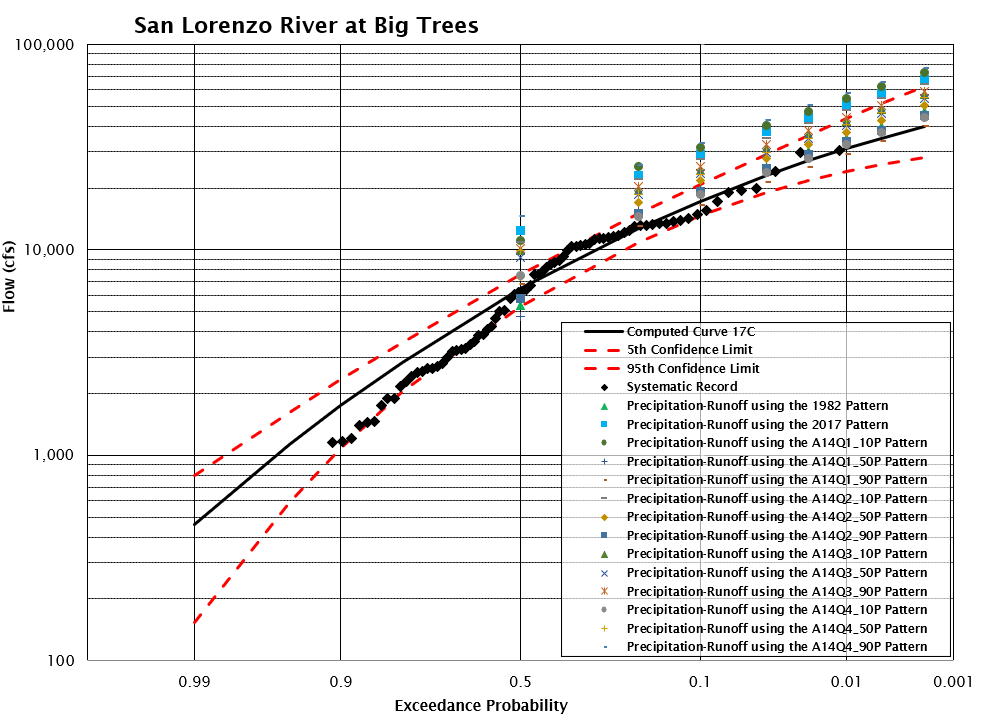
The flow frequency results computed by the HEC-HMS model were copied to an Excel spreadsheet and the flow values were converted to Log base 10. Then the variance and mean were computed for each AEP. The following table contains the variance and median flow (Log) from the HEC-HMS simulations.
AEP Variance (Log Flow) Median (Log Flow) 0.5 0.0193 3.9804 0.2 0.0081 4.2687 0.1 0.0077 4.3683 0.04 0.0076 4.4740 0.02 0.0076 4.5437 0.01 0.0074 4.6077 0.005 0.0072 4.6669 0.002 0.0069 4.7392 The weighted flow frequency curve was computed using equation 9-2 in Bulletin 17C. All flow and variance values were in log space when computing the weighted flow frequency curve. The following table and plot show the individual flow frequency curves and the weighted flow frequency curve.
AEP Bulletin 17C Flow Frequency Curve (cfs) Bulletin 17C Variance (Log Flow) HEC-HMS Results Median Curve (cfs) HEC-HMS Results Variance (Log Flow) Weighted Flow Frequency Curve (cfs) 0.99 463 0.0373 - - - 0.95 1131 0.0151 - - - 0.9 1746 0.0090 - - - 0.8 2842 0.0050 - - - 0.5 6451 0.0022 9559 0.0193 6711 0.2 12734 0.0017 18565 0.0081 13601 0.1 17248 0.0020 23350 0.0077 18363 0.04 22973 0.0030 29783 0.0076 24721 0.02 27118 0.0042 34968 0.0076 29683 0.01 31096 0.0057 40521 0.0074 34900 0.005 34902 0.0077 46443 0.0072 40422 0.002 39664 0.0107 54856 0.0069 48282 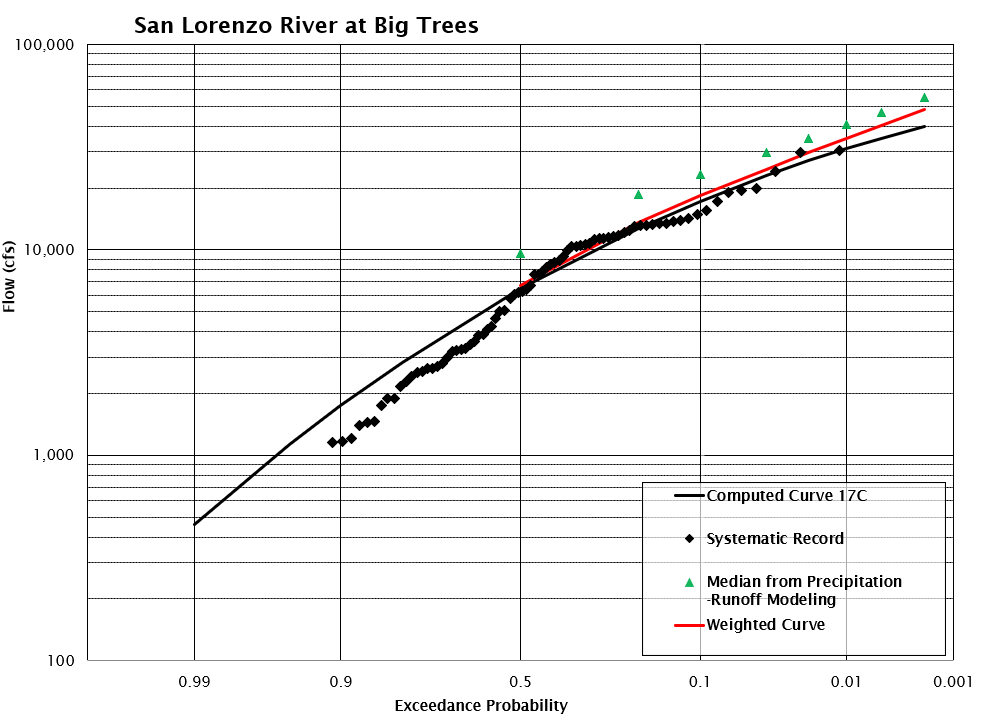
The weighted variance for each ordinate was computed using equation 9-3 in Bulletin 17C. Using the weighted variance, a 90% confidence interval (i.e. 5- and 95-percent confidence limits) was computed using equation 9-4 in Bulletin 17C. The following table and plot show the weighted variance, 5-, and 95-percent confidence limits.
A t-value of 1.654 was used when computing the 90% confidence interval.
AEP Weighted Variance (log base 10) 5% Confidence Limit (cfs) 95% Confidence Limit (cfs) 0.5 0.0019 7930 5679 0.2 0.0014 15687 11792 0.1 0.0016 21359 15788 0.04 0.0021 29460 20745 0.02 0.0027 36133 24385 0.01 0.0032 43301 28129 0.005 0.0037 50936 32078 0.002 0.0042 61725 37767 
The B17C curve and weighted curve, along with their 90% confidence limits, were compared against one another. The width of the 90% confidence limit was significantly reduced for rare AEP when precipitation-runoff results were combined with the B17C results, as shown in the following table and figure.
AEP B17C 90% Confidence Interval Width (cfs) Weighted 90% Confidence Interval Width (cfs) 0.5 2295 2252 0.2 4113 3895 0.1 6125 5571 0.04 10114 8714 0.02 14241 11748 0.01 19311 15173 0.005 25300 18858 0.002 34596 23958 